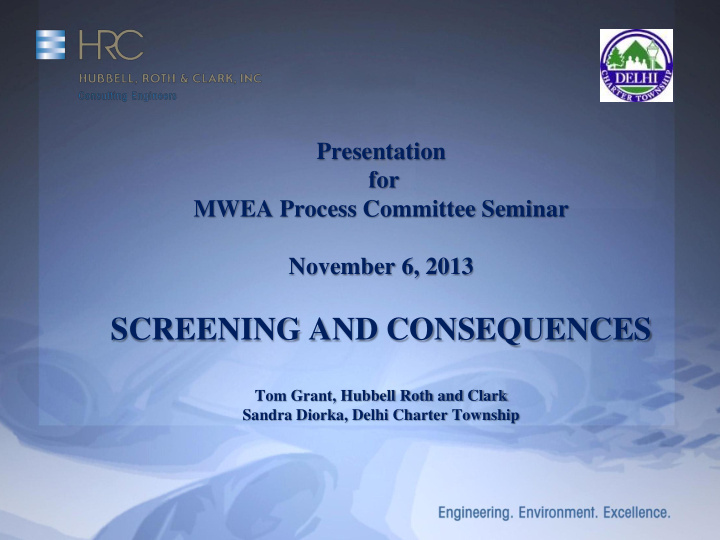



Presentation for MWEA Process Committee Seminar November 6, 2013 SCREENING AND CONSEQUENCES Tom Grant, Hubbell Roth and Clark Sandra Diorka, Delhi Charter Township
Need for Project Class A Sludge Anaerobic Digestion System Heat Exchangers Plugging
Plugging Heat Exchangers All raw sludge is macerated such that fibers, plastics, etc. are relatively small, about ¼” wide x 3” to 6” long During sludge recirculation and pumping through 1 1/4” and 3” diameter heat exchanger tubes, small pieces become entwined and form ropes that plug the heat exchangers Heat exchangers required cleaning every other day
Plugging Heat Exchangers
Existing Not Effective Existing headworks grinding with capture was not effectively removing screenable materials from wastewater Requires seasonal cleaning of primary clarifiers and disposal of wet settlings to drying beds Causing early wear on POTW equipment Excessive labor spent removing rags from all process equipment Wasting pumps Telescopic valves Decant valves Digester heat exchangers
Existing Not Effective
Existing Not Effective Removal of about 40 pounds wet material per day
New Screen Selection: Site Visits, Round 1 Traditional bar screens Visited Michigan WWTPs to view their headworks screens: South Lyon, ¼” bar Grand Rapids, ¼” bar
Bar Screen Observations During site visits noticed: Bar screens had excessive pass through Equipment had grease balls and strings hanging Resulting screenings were very dirty Bar screen room and environment was gross Primaries, aeration tanks, and secondaries had floaters Conclusion: Bar screens are not so good. What else can we get?
Pilot Testing at POTW How do we pick between round holes and slots (bar screen)? How big should the holes be? Devised an in house experiment Fabricated a slide gate with four different “screens” built in 1/8 inch round hole (perforated plate) 1/4 inch round hole 1/4 inch “bar” hole Window screen (around 1mm hole size)
Pilot Testing at POTW Placed each gate in the influent channel for a specified time Weighed the material collected Window screen was considered “100%” capture Roughly 8000 pounds per day Round holes collected roughly 4 times the amount of material as the bar or slot shaped openings Conclusion: We want round holes!!
New Screen Selection: Site Visits, Round 2 North Kent, 1 to 3 mm drum screen
New Screen Selection: Site Visits, Round 2 Kalamazoo, 6 mm bandscreen Screen entrance is sealed to channel Flow In Flow Out
Discovered and Purchased U.K. Study Purchased “National Screen Evaluation Facility, Inlet Screen Comparative Report” performed between 1999 and 2011 by the UK Water Industry Research Installed and compared the performance of 27 different headworks treatment products Finescreen Stepscreen Combined screen (bar or round with processing) Bandscreen Reported % capture of material Maintenance frequency
Finescreen • Screen rotates around to carry stuff to the top • Can have round or bar openings
Stepscreen • Like a fine screen • Steps move and transport stuff to the top – body of the screen holds still
Discovered and Purchased U.K. Study Bandscreens showed the best performance Highest screen capture rate Lowest risk of “pass through” or “carry over” because of seal between opening and the channel Study showed two brands had the highest screen capture rate Screens incorporating slots or bar spacing showed the lowest performance Conclusion: We want one of the bandscreens with the highest capture rate!
Site Visits Round 3 Made a three day trip to visit four additional screens Ishpeming, MI – Jones and Atwood band, 6 mm holes Sheboygan, WI – Brackett Green band, 6 mm holes Madison, WI – Brackett Green band, 6 mm holes Fond du Lac, WI – JWC Fine Screen, 3 mm holes
Site Visits Ishpeming
Site Visits Sheboygan
The Final Decision How did we decide? The cleanest end product 3mm because Madison had 6mm hole size with the same type of heat exchanger Heat exchangers still plugged Fond du Lac had 3mm hole size with the same type of heat exchanger Heat exchangers did NOT plug!!
What Happened After ? Heat exchangers no longer routinely cleaned Primaries have no rags or floating “salad” Grease hauled less often (contains only grease) Aeration tanks do not have to be “skimmed” No more condoms Wasting pumps no longer need to be routinely cleaned Sludge storage decant valves have remained clean Telescopic valves no longer have to be cleaned
Screenings Production 1200 1000 800 600 400 200 0
Raw Sludge % Volatile 88.0 86.0 84.0 82.0 80.0 78.0 76.0 74.0 72.0 After Before 70.0
Grit Production 500 450 400 350 300 250 200 150 100 50 0
Before – NOT Gritty
After – Actually Grit
Engineering and Construction Design Engineering 2 screens, each handle 6 mgd, bypass/overflow manually cleaned channel 5 mgd Tight site – fit between existing influent screw pumps, grit tank and primary clarifiers Existing hydraulic grade line is fixed Poor soils for building & channels foundation
Tight Site
Poor Soils Helical Screw Piles Foundation
Construction Extended schedule due to piles, originally June 2012 completion, first screen started in October 2012 Alternate bypass
Construction Gravity Bypass
Construction
Construction
Construction
Construction
Results
Results
Questions??
Recommend
More recommend